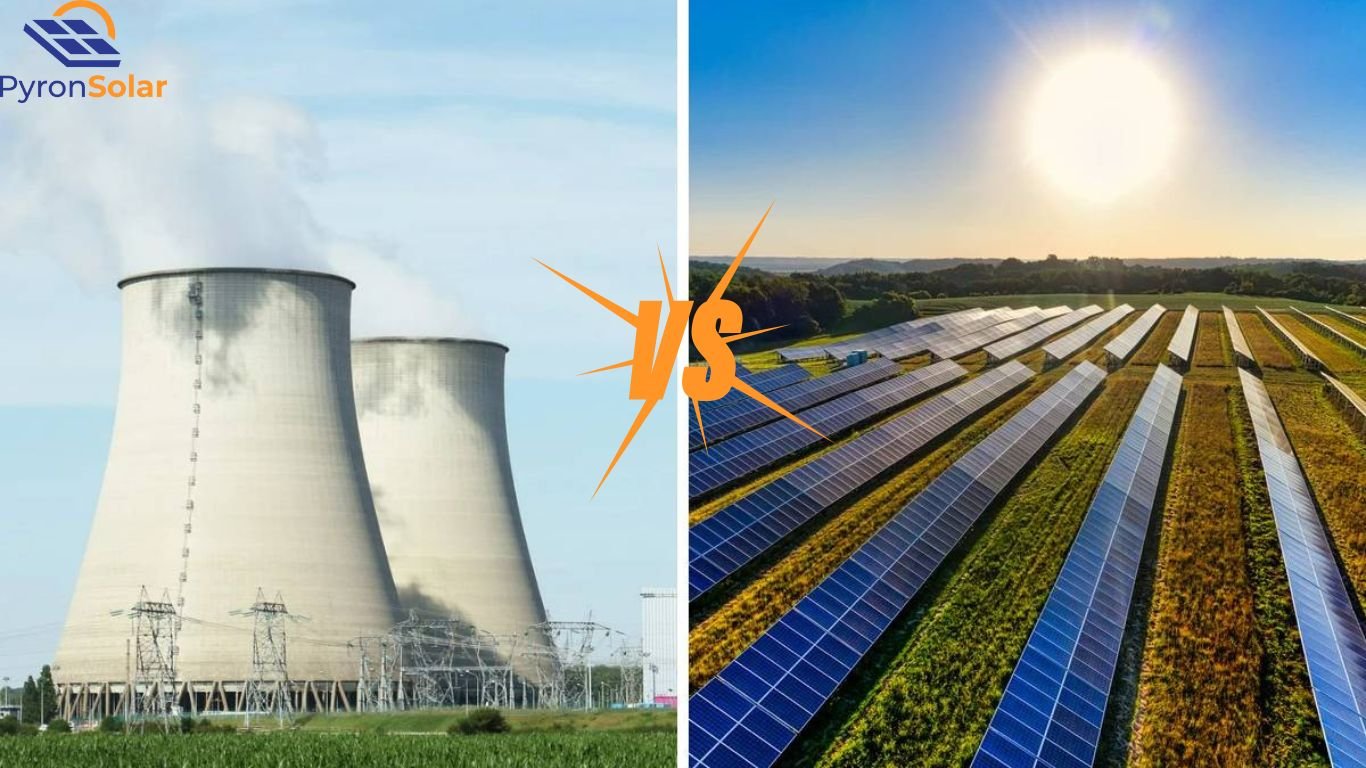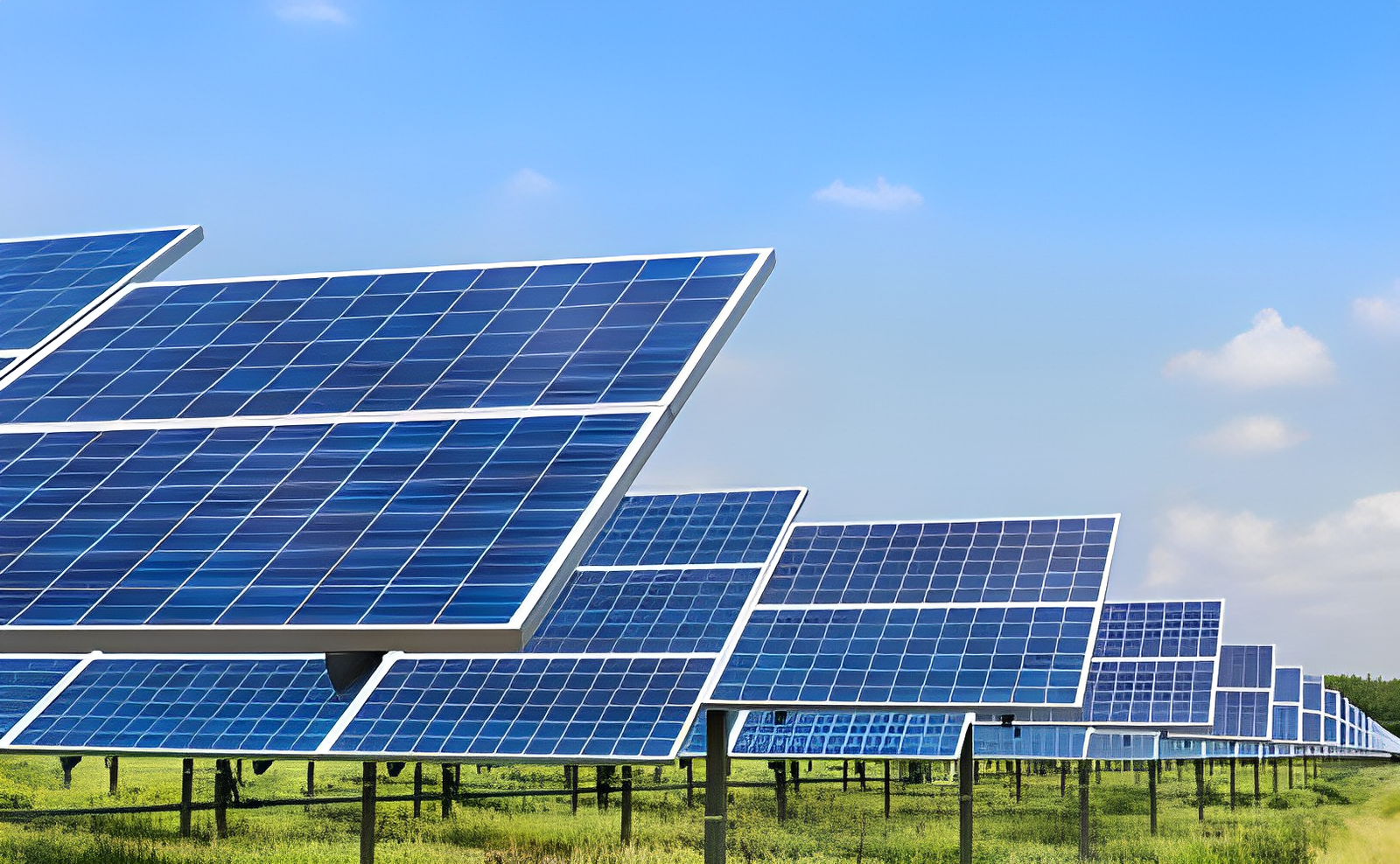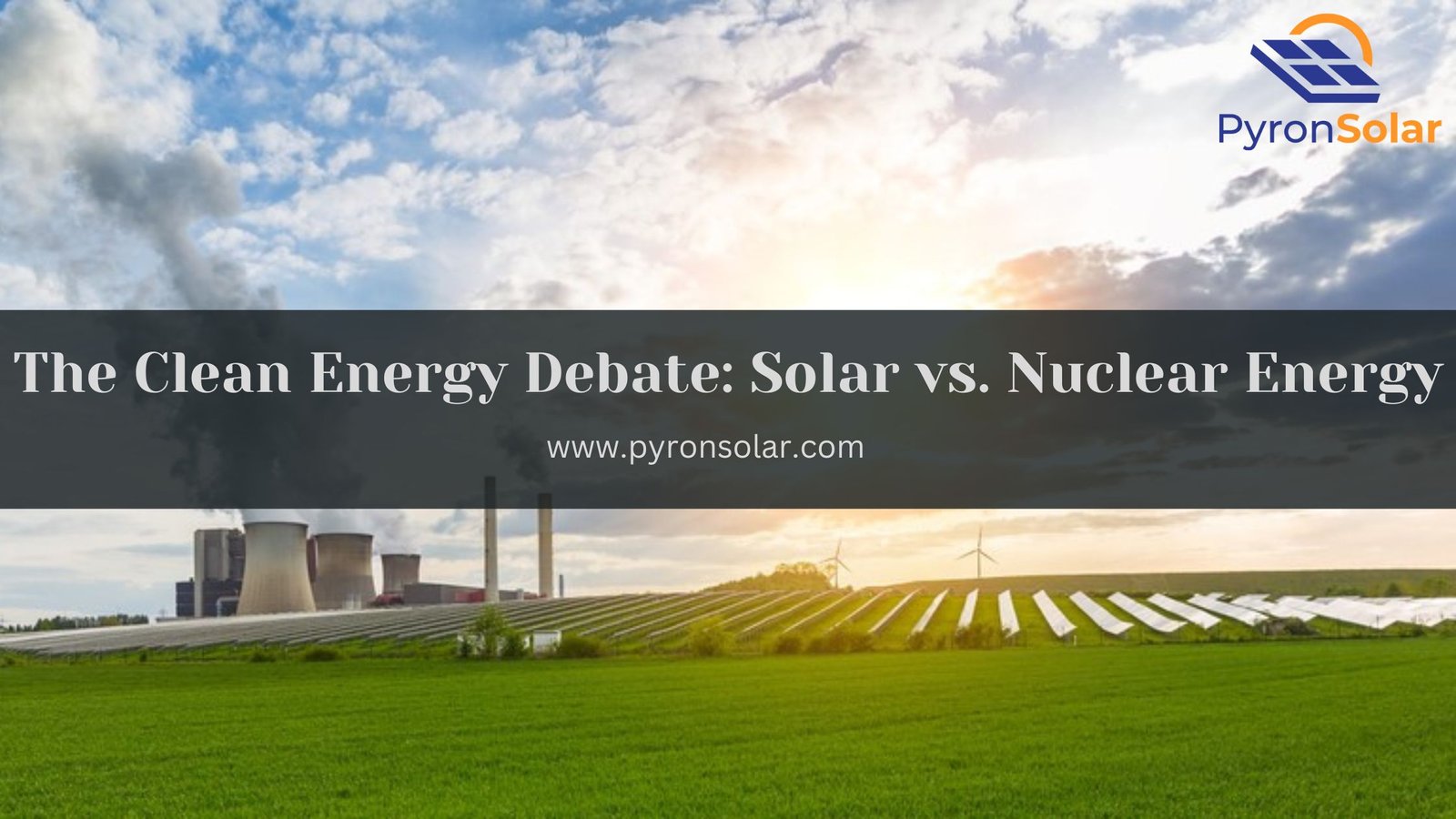In recent years, Solar energy popularity has seen rapid growth due to technological advancements, decreasing solar panel costs, and increasing environmental issue awareness. Whereas, Nuclear energy popularity fluctuated due to safety concerns about nuclear contamination, radioactive waste disposal, and the high costs of building and maintaining nuclear power plants.
Therefore, many countries are adopting nuclear energy, with some expanding its use and others gradually phasing it out due to its high cost. Study shows that developing country like Ghana have the opportunity to reduce their cost of electricity significantly US has 1 and majority from India any of these 2 energy.
Solar energy is produced from the sun’s rays, which are converted into electricity using photovoltaic panels or can be used for direct heating purposes through solar thermal systems.
Nuclear energy is created by the breakdown of uranium or plutonium atoms in nuclear reactors and generates huge amounts of heat energy, which can further be converted into electricity.

Fossil fuel-based power plants, both Solar Energy and Nuclear Energy are carbon-free sources of electricity because their electricity-generating processes do not release carbon dioxide(CO2) or other greenhouse gases(GHG) into the environment.
Before understanding solar energy, you need to understand a glimpse of the Pros and Cons. Also, to compare Solar and Nuclear Energy, various factors like Cost, Installation Time, Energy Production, Environmental Impact, and Public Perception. Additionally, you will be able to determine the better energy between solar and nuclear by knowing how efficient are they by analyzing if they are renewable or non-renewable and have a good impact on the environment or not.
Understanding Solar Energy

Solar energy is turned into electricity using photovoltaic (PV) panels or solar thermal systems. Photovoltaic panels convert sunlight directly into electricity using semiconductor materials, while solar thermal systems use mirrors or lenses to concentrate sunlight onto a small area, generating heat that can be used to produce electricity or for heating purposes.
The different types of PV and Solar Thermal are:
PV (Photovoltaic): PV systems convert sunlight directly into electricity using solar cells made of semiconductor materials like silicon. These PV cells are typically found in solar panels installed on rooftops or in solar farms.
Solar Thermal: Solar thermal systems use mirrors or lenses to concentrate sunlight onto a small area, heating a fluid such as water or oil. This heated fluid generates steam to drive turbines for electricity production. Solar thermal systems are commonly used in large-scale power plants.
Where are solar panels used in homes, businesses, and solar plants?
Homes: Solar panels are commonly installed on rooftops of homes to generate electricity for household use.
Businesses: Solar panels are also installed on the rooftops or open land of commercial buildings to offset electricity consumption and reduce energy costs.
Solar Plants: Large-scale solar plants, also known as solar farms, are built in open areas with high solar exposure to generate electricity for communities or utility-scale purposes.
Here, I have provided well-researched from various sources and provided the number of solar panels installed in the USA. As of 2021, the number of solar panels installed in the USA is estimated to be over 89.5 million, with a total installed solar capacity exceeding 100 gigawatts.
Pros and Cons of Solar Energy
Here are the pros and cons of solar energy tabulated below:
| S. No | Pros | Cons |
| 1. | Pollution Free | Weather Dependent |
| 2. | Renewable and Infinite Energy Source | Higher upfront costs |
| 3. | Improved solar cell durability | Cannot generate energy during night or rainy days |
| 4. | Easy to install | Hazardous materials injected during the manufacturing process |
| 5. | Less Maintenance and Operational Costs | Recycling and Disposal Problems |
If you want to install a solar panel system, then you should know in detail the pros and cons of solar energy so that you can make the right decisions.
Understanding Nuclear Energy

From the nucleus of atoms of radioactive materials, nuclear energy is extracted through various reactions. Consequently, the nuclear energy from the nucleus is released, which generates thermal energy. Also, nuclear energy can be obtained through nuclear fission, fusion, and decay.
Nuclear Energy is used in various applications like powering desalination plants, supplying heat for metal refining, generating hydrogen as a clean and alternative fuel for vehicles, medical applications like diagnostics and radiation therapy, space exploration, and several others.
A total of 54 Nuclear Power Plants are operated in the USA as of 1st August 2023, which includes 93 nuclear power reactors in 28 states.
Pros and Cons of Nuclear Energy
The pros and cons of nuclear energy are tabulated below:
| S. No | Pros | Cons |
| 1. | Less greenhouse gas emissions | Radioactive wastes stay dangerous for thousands of years. |
| 2. | Highly reliable electricity and base load source | High accident risk |
| 3. | High capacity to meet all energy demands globally | High initial cost |
| 4. | Cost-effective with high energy density | Non-renewable energy source |
| 5. | Longer operational lifespan of 40 to 60 years | Higher environmental risks, particularly affecting marine lives |
Solar vs Nuclear Energy: Comparison
The comparison of solar and nuclear energy can be understood easily by considering these factors:
- Cost
- Installation Time
- Energy Production
- Environmental Impact
- Public Perception
Cost
According to the Solar Energy Industries Association (SEIA), the residential solar panels cost can be up to $25,000 per installation and $6 to $9 billion for Nuclear power plants.
As of 2023, the nuclear power plants’ average installation cost per kilowatt kW(in the USA varies between $8,475 and $13,925, whereas for solar energy it ranges between 2,500 to 3,500 USD per kW approximately, and it is much cheaper than nuclear energy.
Installation Time
Solar Energy for residential buildings typically requires 1–3 months of installation and 12–18 months for utility-scale farms, which is less than a nuclear power plant requiring 5 to 10 years.
A Solar power plant costs 1/10th of a nuclear power plant due to its less complex infrastructure that requires less construction time and technological investments and doesn’t require any additional fuel assets for operation.
Energy Production
The energy production of a 5kW solar system varies between 6,000 to 9,000 kWh per year, depending upon sunlight and location. According to the U.S. Energy Information Administration (EIA), 778,188 million kWh of energy is generated per year.
Nuclear energy being a reliable power generation source produces more energy than solar energy due to its high capacity factor, fuel density, independent weather conditions performance, and continuous operation with advanced technology.
Environmental Impact
Solar energy has several positive and negative impacts on the environment:
POSITIVE IMPACTS:
- A renewable and sustainable energy source that neither emits greenhouse gases during operation nor depletes over a certain time.
- Reduces dependence on centralized power grids and fossil fuels.
- Avoids air and water pollution while functioning.
NEGATIVE IMPACTS:
- Inconsistent power generation.
- Highly dependent on sunny weather conditions.
- Land conflicts.
- Manufacturing and recycling challenges.
Despite solar panels not emitting harmful gases during operation, their production and disposal are enormous challenges. The ongoing recycling technology development hasn’t been effective in treating solar waste, as the separation of precious materials from unwanted ones is a complicated process. Other than these impacts, there are so many other environmental impacts of solar energy.
Similarly, nuclear energy has several positive and negative impacts on the environment:
POSITIVE IMPACTS:
- Reduced greenhouse gas emissions.
- Energy security with better geographical distribution.
- High base load power to support the grid irrespective of weather conditions.
NEGATIVE IMPACTS:
- Huge radioactive waste that presents long-term challenges.
- More nuclear accidents and radioactive releases.
- National security risks by having the potential to use for weapons.
Public Perception
The electricity generation from solar energy has risen from 2.8% in 2021 to 3.4% in 2023 due to technological advancements and cost reduction with various incentives and rebates in the US and other parts of the world.
Many people consider Nuclear energy as unsafe due to the high cost of nuclear power plants and the complexities of handling radioactive wastes.
Also, many nuclear accidents have occurred in the past in the USA and other countries. For instance, the Fukushima Daiichi accident in 2011 forced the Japanese government to decrease nuclear power dependence and initiated other countries to reconsider their plans for nuclear energy. Similarly, the Chernobyl accident in 1986 killed 30 operators and firemen within three months in Ukraine.
According to the U.S. Energy Information Administration, there are 93 nuclear power reactors, that generate 18.2% of electricity in the entire nation. Half of the nuclear power reactors (47) are in the South, whereas a quarter (22) are in the Midwest, 18 reactors in the Northeast, and 6 in the west of the US.
Solar Energy vs Nuclear Energy: Which is better?
Both solar energy and nuclear energy have their positive and negative effects. Solar energy is abundant, and environmentally friendly but can be unstable and require large land areas for its implementation. On the other hand, Nuclear energy provides constant base load power with minimal greenhouse gas (GHG) emissions but also comes with risks like radioactive waste disposal and potential accidents.
If you ask which one is better – Solar energy or Nuclear energy? In the long term, solar energy will prove to be a more economical option due to its renewable nature, low environmental impact, and decreasing costs with technological advancements. Additionally, solar energy doesn’t create any risks compared to nuclear energy like – accidents or harmful waste.
Both solar and nuclear energies can be used together for maximum output. For instance, Solar energy can be used when sunlight is abundant, while nuclear energy can supply continuous base load power. It ensures a trustworthy energy supply even during low sunlight or at night.
{Video Credit- The Infographics Show}
How efficient is Nuclear Energy compared to other methods?
With 33-37% – Nuclear energy is highly efficient compared to other energy sources. However, efficiency rates can depend on factors like reactor type and design.
Here is a comparison of nuclear energy efficiency compared to other methods:
Traditional coal-fired power plants – 33% Efficiency
Natural Gas Plants – 50-60%
Solar PV Panels – 15-20%
Wind Turbines – 30-40%
Is Nuclear Energy renewable?
NO! Nuclear energy is not renewable, even though nuclear fuel (like Uranium) is naturally present in the Earth’s bottom layer because it is finite and non-renewable in human lifetimes. Once uranium is used in nuclear power stations, it cannot be produced again within a convenient timeframe.
Is Nuclear Energy good for the environment?
Before getting to a conclusion about whether Nuclear Energy is good or bad for the environment, have a glimpse of its major positive and negative impacts.
POSITIVE IMPACTS:
- Electricity Production with minimal Greenhouse Gas (GHG) emissions
- Helps fight climate change.
- Environmentally friendly compared to other renewable energy (solar or wind farms)
NEGATIVE IMPACTS:
- Uranium-based waste generated
- Nuclear reactors’ improper disposal causes long-term health risks.
- Accidents at nuclear power plants
- Life-threatening environmental impacts (Incidents like Chernobyl and Fukushima)
- Environmental harm and health risks due to Uranium mining and processing
Ray is an avid reader and writer with over 25 years of experience serving various domestic and multinational private and public energy companies in the USA.

